Woolworths Corporate Level Strategies: Evaluation and Recommendations
VerifiedAdded on 2023/06/07
|7
|1706
|389
Report
AI Summary
This report provides an in-depth analysis of Woolworths' corporate-level strategies, focusing on cost leadership and product differentiation within the competitive retail landscape. It examines Woolworths' financial performance, including its capital structure and financial leverage, and evaluates the suitability of its current strategies. The report highlights Woolworths' adoption of cyber computing and enterprise resource planning systems, emphasizing their impact on operational efficiency and customer satisfaction. Furthermore, the report assesses the company's brand image and its ability to compete with rivals such as Tesco and Wesfarmers. The analysis includes recommendations for strategic adjustments, such as customization of retail services and diversification strategies, to enhance market share and financial outcomes. The report also underscores the importance of maintaining a balance between financial leverage and cost of capital to ensure long-term sustainability and competitive advantage. The conclusion summarizes the key findings and emphasizes the importance of continuous strategic evaluation for Woolworths' success.
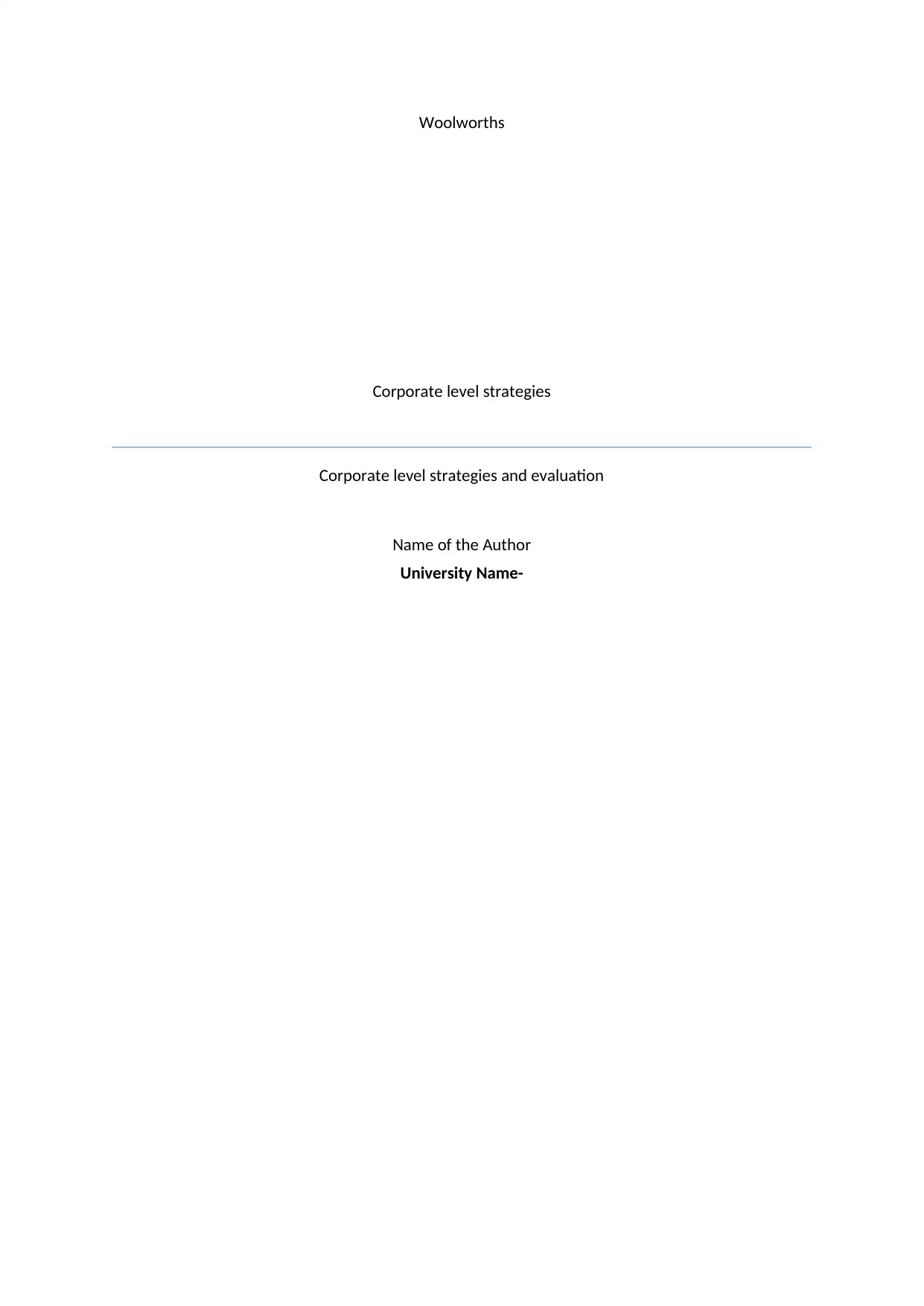
Woolworths
Corporate level strategies
Corporate level strategies and evaluation
Name of the Author
University Name-
Corporate level strategies
Corporate level strategies and evaluation
Name of the Author
University Name-
Paraphrase This Document
Need a fresh take? Get an instant paraphrase of this document with our AI Paraphraser
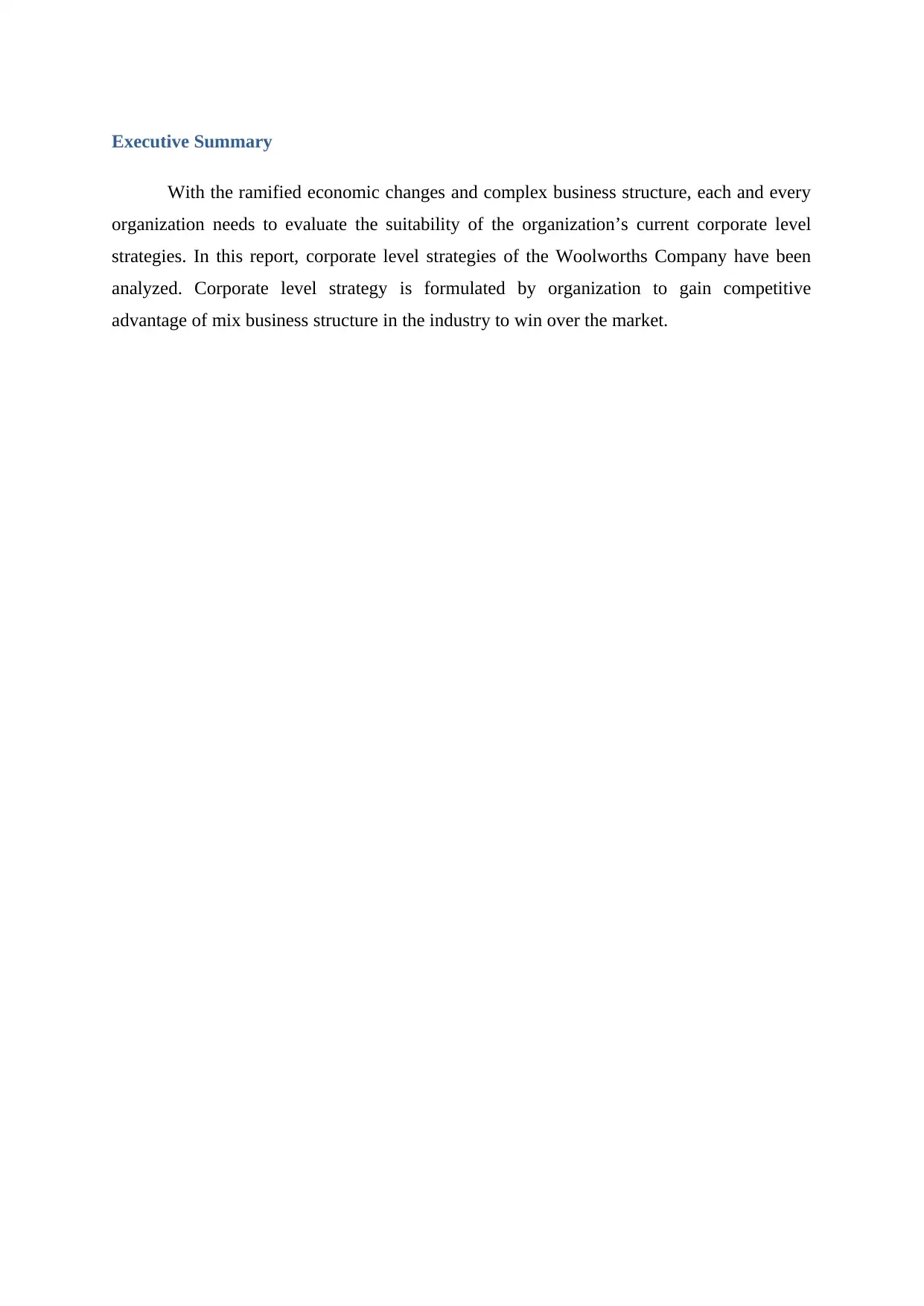
Executive Summary
With the ramified economic changes and complex business structure, each and every
organization needs to evaluate the suitability of the organization’s current corporate level
strategies. In this report, corporate level strategies of the Woolworths Company have been
analyzed. Corporate level strategy is formulated by organization to gain competitive
advantage of mix business structure in the industry to win over the market.
With the ramified economic changes and complex business structure, each and every
organization needs to evaluate the suitability of the organization’s current corporate level
strategies. In this report, corporate level strategies of the Woolworths Company have been
analyzed. Corporate level strategy is formulated by organization to gain competitive
advantage of mix business structure in the industry to win over the market.
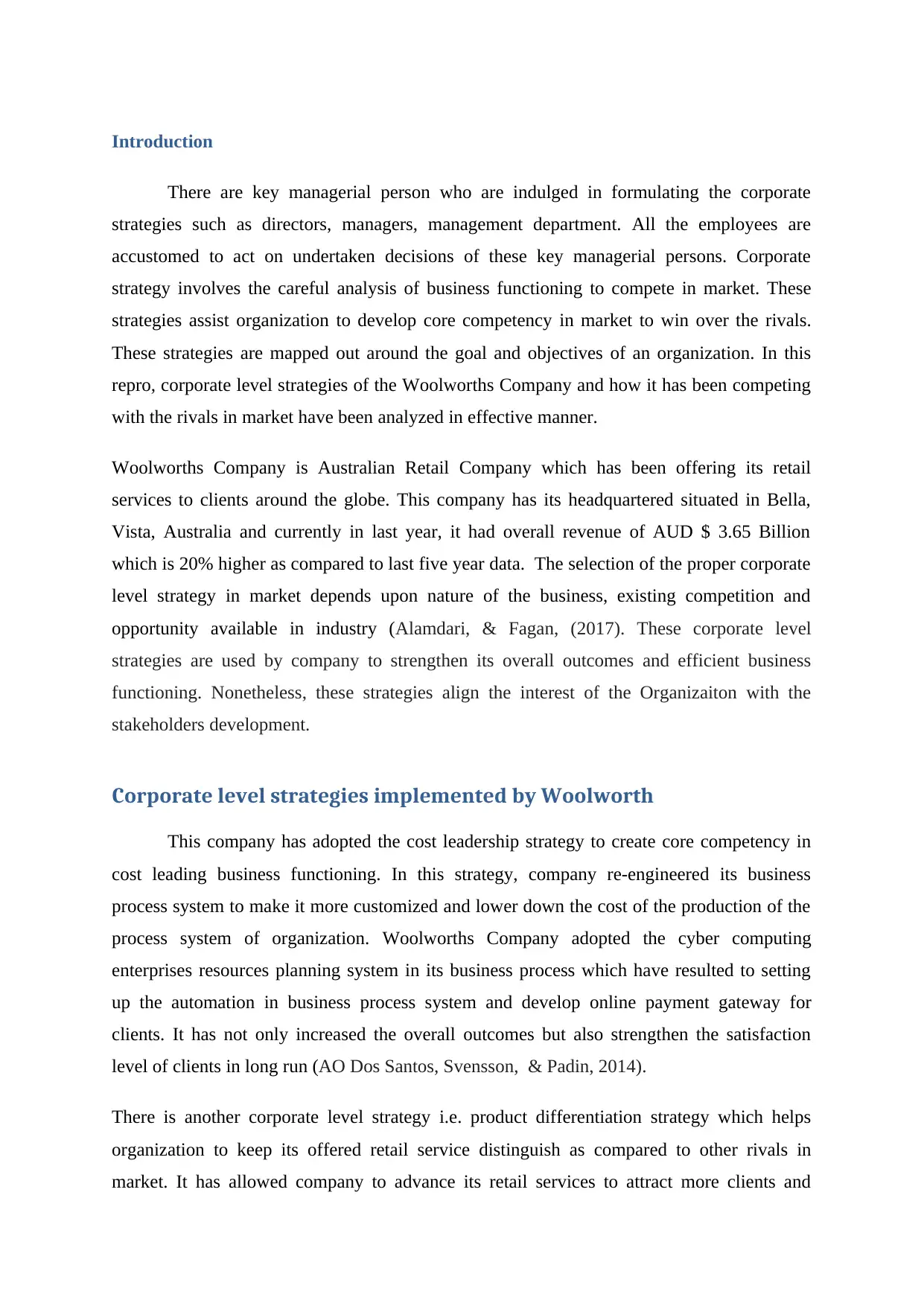
Introduction
There are key managerial person who are indulged in formulating the corporate
strategies such as directors, managers, management department. All the employees are
accustomed to act on undertaken decisions of these key managerial persons. Corporate
strategy involves the careful analysis of business functioning to compete in market. These
strategies assist organization to develop core competency in market to win over the rivals.
These strategies are mapped out around the goal and objectives of an organization. In this
repro, corporate level strategies of the Woolworths Company and how it has been competing
with the rivals in market have been analyzed in effective manner.
Woolworths Company is Australian Retail Company which has been offering its retail
services to clients around the globe. This company has its headquartered situated in Bella,
Vista, Australia and currently in last year, it had overall revenue of AUD $ 3.65 Billion
which is 20% higher as compared to last five year data. The selection of the proper corporate
level strategy in market depends upon nature of the business, existing competition and
opportunity available in industry (Alamdari, & Fagan, (2017). These corporate level
strategies are used by company to strengthen its overall outcomes and efficient business
functioning. Nonetheless, these strategies align the interest of the Organizaiton with the
stakeholders development.
Corporate level strategies implemented by Woolworth
This company has adopted the cost leadership strategy to create core competency in
cost leading business functioning. In this strategy, company re-engineered its business
process system to make it more customized and lower down the cost of the production of the
process system of organization. Woolworths Company adopted the cyber computing
enterprises resources planning system in its business process which have resulted to setting
up the automation in business process system and develop online payment gateway for
clients. It has not only increased the overall outcomes but also strengthen the satisfaction
level of clients in long run (AO Dos Santos, Svensson, & Padin, 2014).
There is another corporate level strategy i.e. product differentiation strategy which helps
organization to keep its offered retail service distinguish as compared to other rivals in
market. It has allowed company to advance its retail services to attract more clients and
There are key managerial person who are indulged in formulating the corporate
strategies such as directors, managers, management department. All the employees are
accustomed to act on undertaken decisions of these key managerial persons. Corporate
strategy involves the careful analysis of business functioning to compete in market. These
strategies assist organization to develop core competency in market to win over the rivals.
These strategies are mapped out around the goal and objectives of an organization. In this
repro, corporate level strategies of the Woolworths Company and how it has been competing
with the rivals in market have been analyzed in effective manner.
Woolworths Company is Australian Retail Company which has been offering its retail
services to clients around the globe. This company has its headquartered situated in Bella,
Vista, Australia and currently in last year, it had overall revenue of AUD $ 3.65 Billion
which is 20% higher as compared to last five year data. The selection of the proper corporate
level strategy in market depends upon nature of the business, existing competition and
opportunity available in industry (Alamdari, & Fagan, (2017). These corporate level
strategies are used by company to strengthen its overall outcomes and efficient business
functioning. Nonetheless, these strategies align the interest of the Organizaiton with the
stakeholders development.
Corporate level strategies implemented by Woolworth
This company has adopted the cost leadership strategy to create core competency in
cost leading business functioning. In this strategy, company re-engineered its business
process system to make it more customized and lower down the cost of the production of the
process system of organization. Woolworths Company adopted the cyber computing
enterprises resources planning system in its business process which have resulted to setting
up the automation in business process system and develop online payment gateway for
clients. It has not only increased the overall outcomes but also strengthen the satisfaction
level of clients in long run (AO Dos Santos, Svensson, & Padin, 2014).
There is another corporate level strategy i.e. product differentiation strategy which helps
organization to keep its offered retail service distinguish as compared to other rivals in
market. It has allowed company to advance its retail services to attract more clients and
⊘ This is a preview!⊘
Do you want full access?
Subscribe today to unlock all pages.

Trusted by 1+ million students worldwide
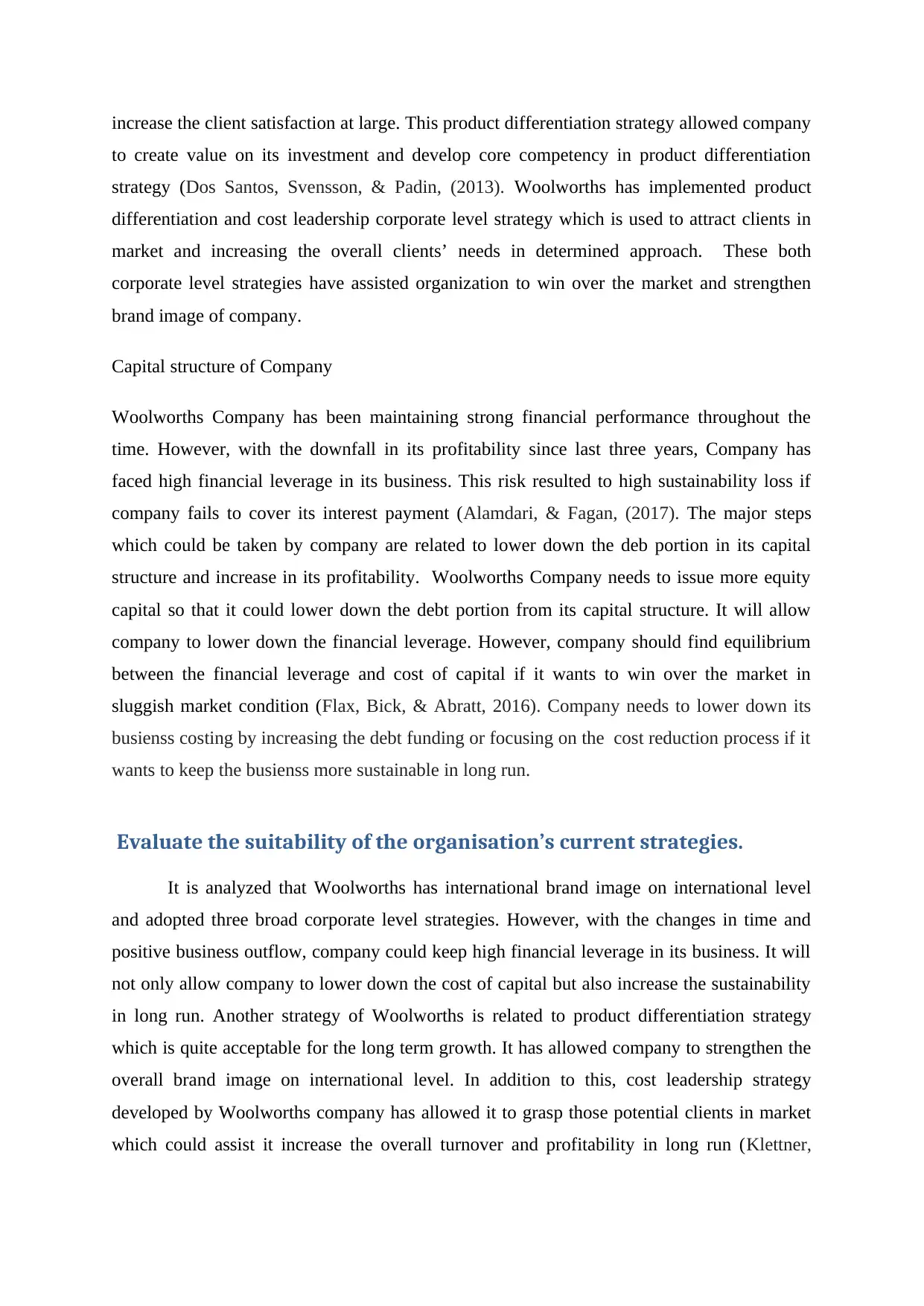
increase the client satisfaction at large. This product differentiation strategy allowed company
to create value on its investment and develop core competency in product differentiation
strategy (Dos Santos, Svensson, & Padin, (2013). Woolworths has implemented product
differentiation and cost leadership corporate level strategy which is used to attract clients in
market and increasing the overall clients’ needs in determined approach. These both
corporate level strategies have assisted organization to win over the market and strengthen
brand image of company.
Capital structure of Company
Woolworths Company has been maintaining strong financial performance throughout the
time. However, with the downfall in its profitability since last three years, Company has
faced high financial leverage in its business. This risk resulted to high sustainability loss if
company fails to cover its interest payment (Alamdari, & Fagan, (2017). The major steps
which could be taken by company are related to lower down the deb portion in its capital
structure and increase in its profitability. Woolworths Company needs to issue more equity
capital so that it could lower down the debt portion from its capital structure. It will allow
company to lower down the financial leverage. However, company should find equilibrium
between the financial leverage and cost of capital if it wants to win over the market in
sluggish market condition (Flax, Bick, & Abratt, 2016). Company needs to lower down its
busienss costing by increasing the debt funding or focusing on the cost reduction process if it
wants to keep the busienss more sustainable in long run.
Evaluate the suitability of the organisation’s current strategies.
It is analyzed that Woolworths has international brand image on international level
and adopted three broad corporate level strategies. However, with the changes in time and
positive business outflow, company could keep high financial leverage in its business. It will
not only allow company to lower down the cost of capital but also increase the sustainability
in long run. Another strategy of Woolworths is related to product differentiation strategy
which is quite acceptable for the long term growth. It has allowed company to strengthen the
overall brand image on international level. In addition to this, cost leadership strategy
developed by Woolworths company has allowed it to grasp those potential clients in market
which could assist it increase the overall turnover and profitability in long run (Klettner,
to create value on its investment and develop core competency in product differentiation
strategy (Dos Santos, Svensson, & Padin, (2013). Woolworths has implemented product
differentiation and cost leadership corporate level strategy which is used to attract clients in
market and increasing the overall clients’ needs in determined approach. These both
corporate level strategies have assisted organization to win over the market and strengthen
brand image of company.
Capital structure of Company
Woolworths Company has been maintaining strong financial performance throughout the
time. However, with the downfall in its profitability since last three years, Company has
faced high financial leverage in its business. This risk resulted to high sustainability loss if
company fails to cover its interest payment (Alamdari, & Fagan, (2017). The major steps
which could be taken by company are related to lower down the deb portion in its capital
structure and increase in its profitability. Woolworths Company needs to issue more equity
capital so that it could lower down the debt portion from its capital structure. It will allow
company to lower down the financial leverage. However, company should find equilibrium
between the financial leverage and cost of capital if it wants to win over the market in
sluggish market condition (Flax, Bick, & Abratt, 2016). Company needs to lower down its
busienss costing by increasing the debt funding or focusing on the cost reduction process if it
wants to keep the busienss more sustainable in long run.
Evaluate the suitability of the organisation’s current strategies.
It is analyzed that Woolworths has international brand image on international level
and adopted three broad corporate level strategies. However, with the changes in time and
positive business outflow, company could keep high financial leverage in its business. It will
not only allow company to lower down the cost of capital but also increase the sustainability
in long run. Another strategy of Woolworths is related to product differentiation strategy
which is quite acceptable for the long term growth. It has allowed company to strengthen the
overall brand image on international level. In addition to this, cost leadership strategy
developed by Woolworths company has allowed it to grasp those potential clients in market
which could assist it increase the overall turnover and profitability in long run (Klettner,
Paraphrase This Document
Need a fresh take? Get an instant paraphrase of this document with our AI Paraphraser
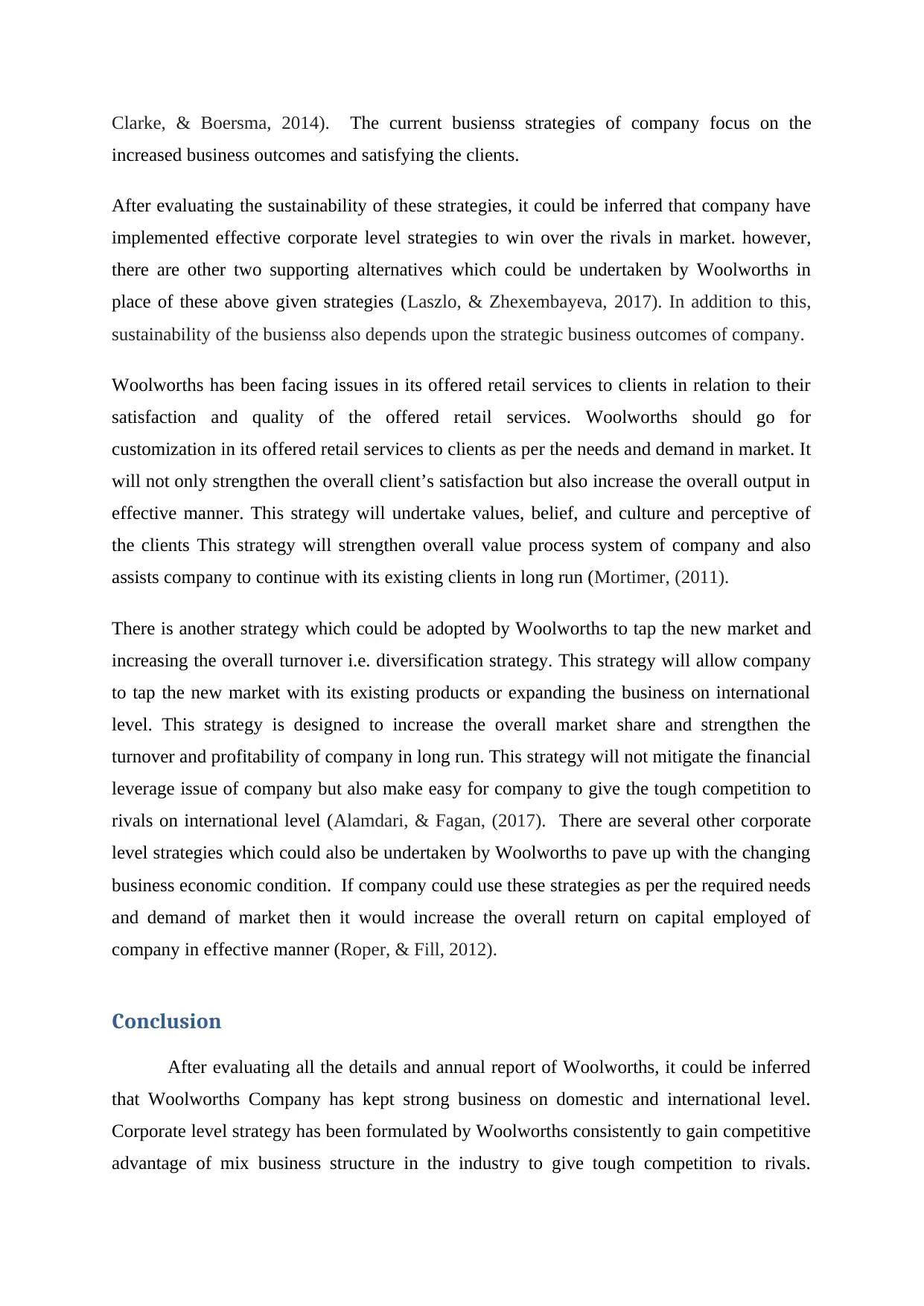
Clarke, & Boersma, 2014). The current busienss strategies of company focus on the
increased business outcomes and satisfying the clients.
After evaluating the sustainability of these strategies, it could be inferred that company have
implemented effective corporate level strategies to win over the rivals in market. however,
there are other two supporting alternatives which could be undertaken by Woolworths in
place of these above given strategies (Laszlo, & Zhexembayeva, 2017). In addition to this,
sustainability of the busienss also depends upon the strategic business outcomes of company.
Woolworths has been facing issues in its offered retail services to clients in relation to their
satisfaction and quality of the offered retail services. Woolworths should go for
customization in its offered retail services to clients as per the needs and demand in market. It
will not only strengthen the overall client’s satisfaction but also increase the overall output in
effective manner. This strategy will undertake values, belief, and culture and perceptive of
the clients This strategy will strengthen overall value process system of company and also
assists company to continue with its existing clients in long run (Mortimer, (2011).
There is another strategy which could be adopted by Woolworths to tap the new market and
increasing the overall turnover i.e. diversification strategy. This strategy will allow company
to tap the new market with its existing products or expanding the business on international
level. This strategy is designed to increase the overall market share and strengthen the
turnover and profitability of company in long run. This strategy will not mitigate the financial
leverage issue of company but also make easy for company to give the tough competition to
rivals on international level (Alamdari, & Fagan, (2017). There are several other corporate
level strategies which could also be undertaken by Woolworths to pave up with the changing
business economic condition. If company could use these strategies as per the required needs
and demand of market then it would increase the overall return on capital employed of
company in effective manner (Roper, & Fill, 2012).
Conclusion
After evaluating all the details and annual report of Woolworths, it could be inferred
that Woolworths Company has kept strong business on domestic and international level.
Corporate level strategy has been formulated by Woolworths consistently to gain competitive
advantage of mix business structure in the industry to give tough competition to rivals.
increased business outcomes and satisfying the clients.
After evaluating the sustainability of these strategies, it could be inferred that company have
implemented effective corporate level strategies to win over the rivals in market. however,
there are other two supporting alternatives which could be undertaken by Woolworths in
place of these above given strategies (Laszlo, & Zhexembayeva, 2017). In addition to this,
sustainability of the busienss also depends upon the strategic business outcomes of company.
Woolworths has been facing issues in its offered retail services to clients in relation to their
satisfaction and quality of the offered retail services. Woolworths should go for
customization in its offered retail services to clients as per the needs and demand in market. It
will not only strengthen the overall client’s satisfaction but also increase the overall output in
effective manner. This strategy will undertake values, belief, and culture and perceptive of
the clients This strategy will strengthen overall value process system of company and also
assists company to continue with its existing clients in long run (Mortimer, (2011).
There is another strategy which could be adopted by Woolworths to tap the new market and
increasing the overall turnover i.e. diversification strategy. This strategy will allow company
to tap the new market with its existing products or expanding the business on international
level. This strategy is designed to increase the overall market share and strengthen the
turnover and profitability of company in long run. This strategy will not mitigate the financial
leverage issue of company but also make easy for company to give the tough competition to
rivals on international level (Alamdari, & Fagan, (2017). There are several other corporate
level strategies which could also be undertaken by Woolworths to pave up with the changing
business economic condition. If company could use these strategies as per the required needs
and demand of market then it would increase the overall return on capital employed of
company in effective manner (Roper, & Fill, 2012).
Conclusion
After evaluating all the details and annual report of Woolworths, it could be inferred
that Woolworths Company has kept strong business on domestic and international level.
Corporate level strategy has been formulated by Woolworths consistently to gain competitive
advantage of mix business structure in the industry to give tough competition to rivals.
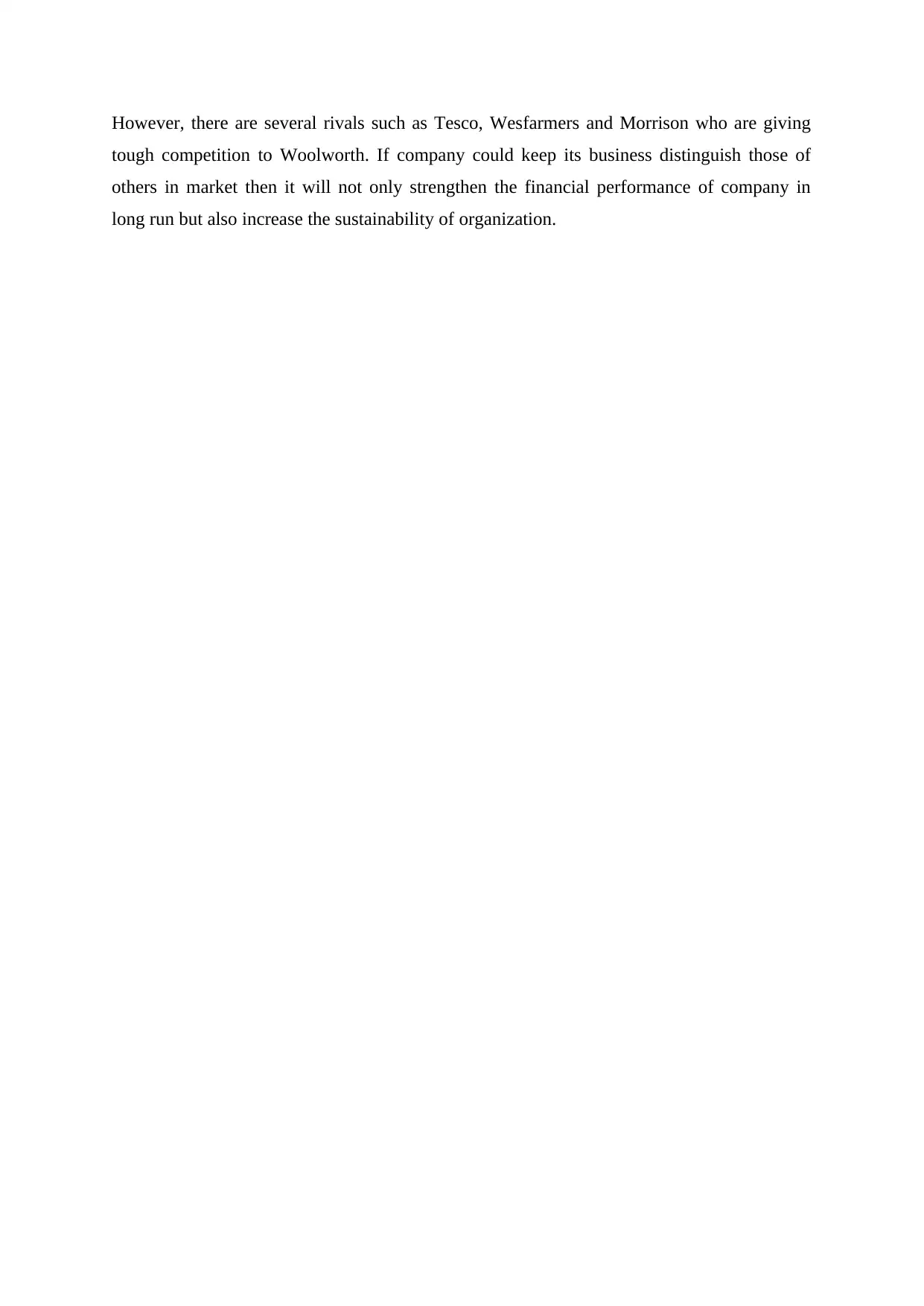
However, there are several rivals such as Tesco, Wesfarmers and Morrison who are giving
tough competition to Woolworth. If company could keep its business distinguish those of
others in market then it will not only strengthen the financial performance of company in
long run but also increase the sustainability of organization.
tough competition to Woolworth. If company could keep its business distinguish those of
others in market then it will not only strengthen the financial performance of company in
long run but also increase the sustainability of organization.
⊘ This is a preview!⊘
Do you want full access?
Subscribe today to unlock all pages.

Trusted by 1+ million students worldwide
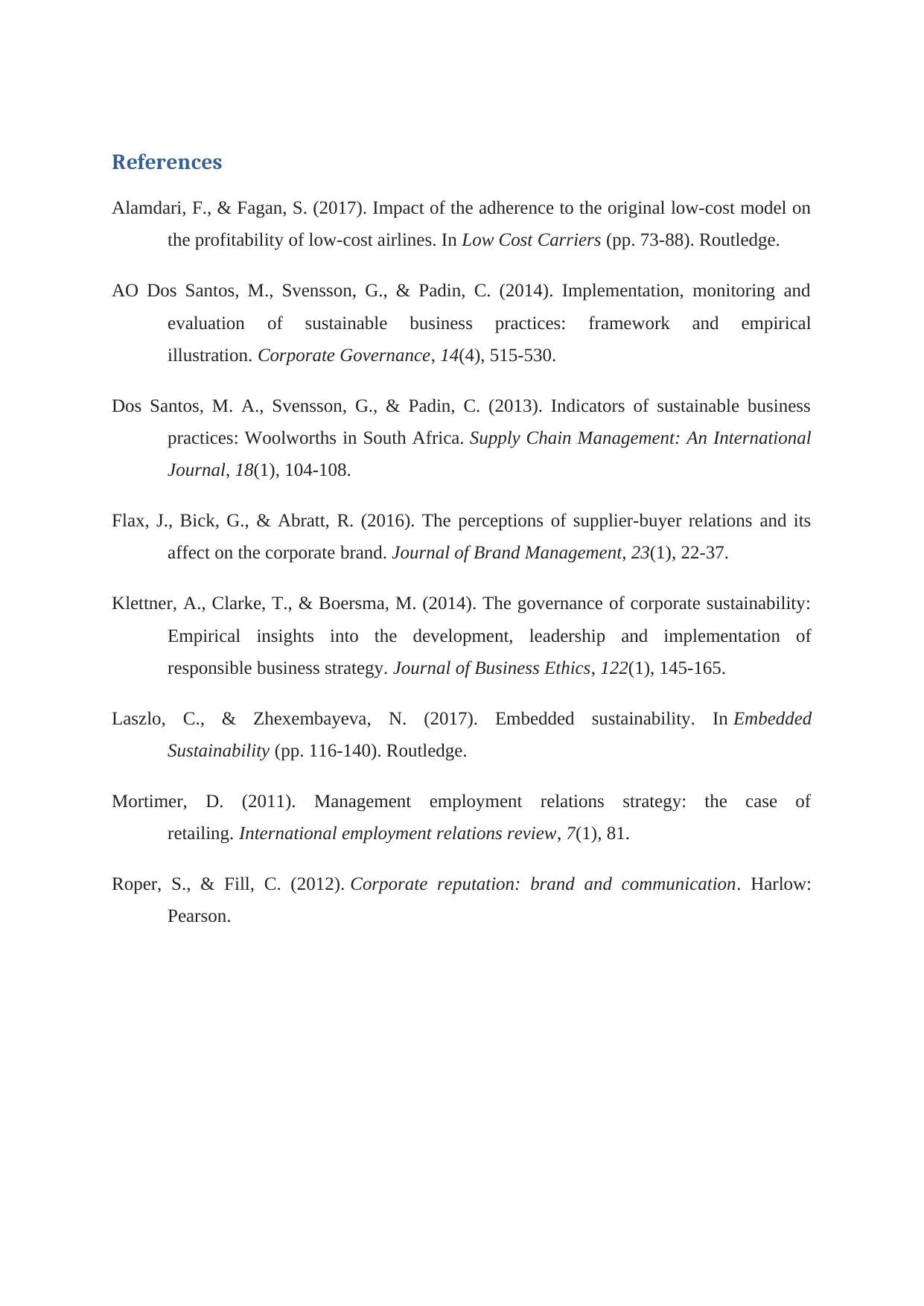
References
Alamdari, F., & Fagan, S. (2017). Impact of the adherence to the original low-cost model on
the profitability of low-cost airlines. In Low Cost Carriers (pp. 73-88). Routledge.
AO Dos Santos, M., Svensson, G., & Padin, C. (2014). Implementation, monitoring and
evaluation of sustainable business practices: framework and empirical
illustration. Corporate Governance, 14(4), 515-530.
Dos Santos, M. A., Svensson, G., & Padin, C. (2013). Indicators of sustainable business
practices: Woolworths in South Africa. Supply Chain Management: An International
Journal, 18(1), 104-108.
Flax, J., Bick, G., & Abratt, R. (2016). The perceptions of supplier-buyer relations and its
affect on the corporate brand. Journal of Brand Management, 23(1), 22-37.
Klettner, A., Clarke, T., & Boersma, M. (2014). The governance of corporate sustainability:
Empirical insights into the development, leadership and implementation of
responsible business strategy. Journal of Business Ethics, 122(1), 145-165.
Laszlo, C., & Zhexembayeva, N. (2017). Embedded sustainability. In Embedded
Sustainability (pp. 116-140). Routledge.
Mortimer, D. (2011). Management employment relations strategy: the case of
retailing. International employment relations review, 7(1), 81.
Roper, S., & Fill, C. (2012). Corporate reputation: brand and communication. Harlow:
Pearson.
Alamdari, F., & Fagan, S. (2017). Impact of the adherence to the original low-cost model on
the profitability of low-cost airlines. In Low Cost Carriers (pp. 73-88). Routledge.
AO Dos Santos, M., Svensson, G., & Padin, C. (2014). Implementation, monitoring and
evaluation of sustainable business practices: framework and empirical
illustration. Corporate Governance, 14(4), 515-530.
Dos Santos, M. A., Svensson, G., & Padin, C. (2013). Indicators of sustainable business
practices: Woolworths in South Africa. Supply Chain Management: An International
Journal, 18(1), 104-108.
Flax, J., Bick, G., & Abratt, R. (2016). The perceptions of supplier-buyer relations and its
affect on the corporate brand. Journal of Brand Management, 23(1), 22-37.
Klettner, A., Clarke, T., & Boersma, M. (2014). The governance of corporate sustainability:
Empirical insights into the development, leadership and implementation of
responsible business strategy. Journal of Business Ethics, 122(1), 145-165.
Laszlo, C., & Zhexembayeva, N. (2017). Embedded sustainability. In Embedded
Sustainability (pp. 116-140). Routledge.
Mortimer, D. (2011). Management employment relations strategy: the case of
retailing. International employment relations review, 7(1), 81.
Roper, S., & Fill, C. (2012). Corporate reputation: brand and communication. Harlow:
Pearson.
1 out of 7
Related Documents
Your All-in-One AI-Powered Toolkit for Academic Success.
+13062052269
info@desklib.com
Available 24*7 on WhatsApp / Email
![[object Object]](/_next/static/media/star-bottom.7253800d.svg)
Unlock your academic potential
Copyright © 2020–2025 A2Z Services. All Rights Reserved. Developed and managed by ZUCOL.





